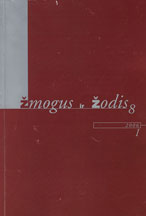Фонетическая терминология и ее фонологические основания
Phonetic Terminology in Relation with Its Phonological Bases
Author(s): Evgenij Frolovič KirovSubject(s): Language and Literature Studies
Published by: Vytauto Didžiojo Universitetas
Keywords: phonetics; sound; term; phoneme; binary system of phonological features; distinctive feature of a phoneme
Summary/Abstract: The article analyses the issues of phonetic terminology and their phonological motivation. In the author's opinion, the phonetic terms used in Russian language phonetics, as well as those used in other languages, developed quite long ago, at the moment when instrumental research of language sounds was not yet formed to a sufficient extent, and, most importantly, the very concept of the phoneme was not yet developed. It is now obvious that the concept of phonetics unites three aspects, i.e. the articulatory, perceptive-acoustic and phonological ones. Thus the system of phonetic terms should be differentiated in every language and split into the three aforementioned subsystems, which should be autonomous and independent of each other, including their related terminology. Language sounds and their peculiarities have been defined up to the present moment most often regardless of this attitude, i.e. characterised using terms of more than one subsystem, including terminology atypical of the given subsystem. The most controversial term is in this case "consonant softening", which can be acceptable in the perceptual, but not in the acoustic or articulatory aspect. Obviously, the above term should be avoided here in general, moreover because this feature of a consonant is understood and defined easier as palatalisation, i.e. a peculiarity emerging due to the tongue approaching the middle of the palate. In the acoustic aspect, a more accurate and more usable equivalent should be "sharpness". Evidently, the majority of problems emerge in development of phonetic terminology due to the wish to define language sounds from the viewpoint of the listener and due to the fact which of their peculiarities and in which ways the listener perceives and identifies. One of such peculiarities is characteristic features of voice timbre. Their identification results in passage of the analysis to another level, i.e. to perceptive phonetics, which is further related with acousme phonetics. An acousme is understood in the present research work as a certain visual-mental copy (image) of a sonic effect existing in reality, necessary for perception of the meaning, its basic distinctive features being specific voice timbre characteristics. In this way, an acousme is understood as a percipient language phoneme unit rather than a unit related to language sounds. Distinction of acousme features (primarily, characteristics of the voice timbre) is the basic issue having the power to clarify the term of acousmophoneme; It is namely the features of timbre that are significant and exceptional for identification and perception of this unit in any language. The article presents Russian language vowel and consonant timbre characteristics forming the system of acousmophonemes.
Journal: Žmogus ir žodis
- Issue Year: 08/2006
- Issue No: 1
- Page Range: 98-111
- Page Count: 14
- Language: Lithuanian

